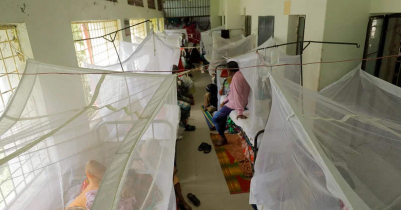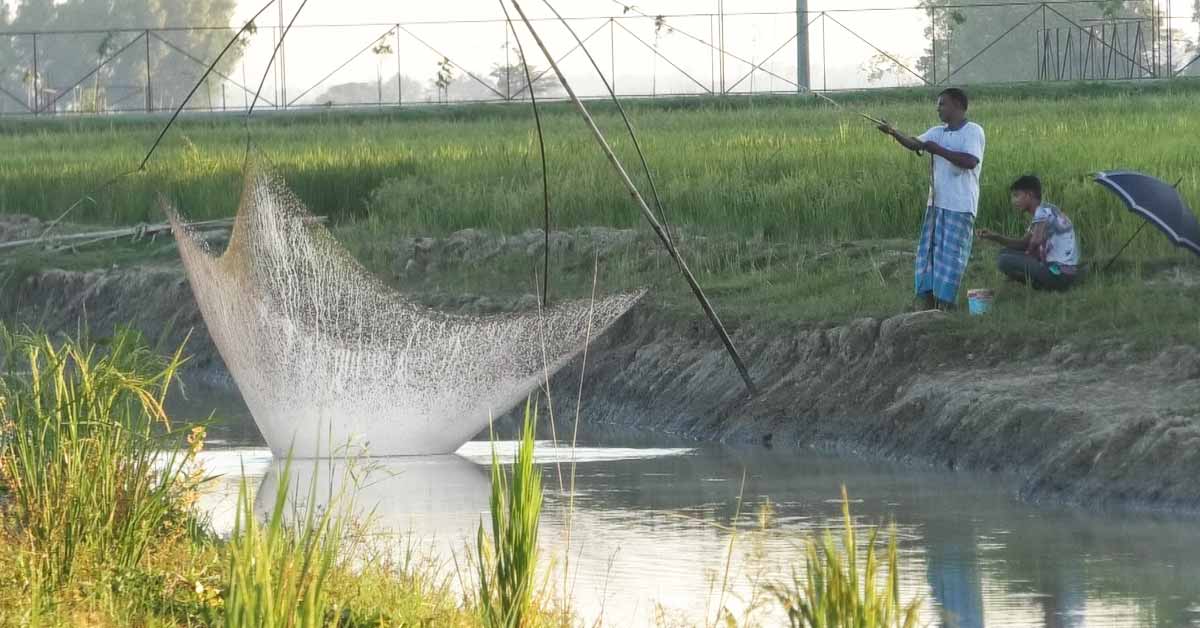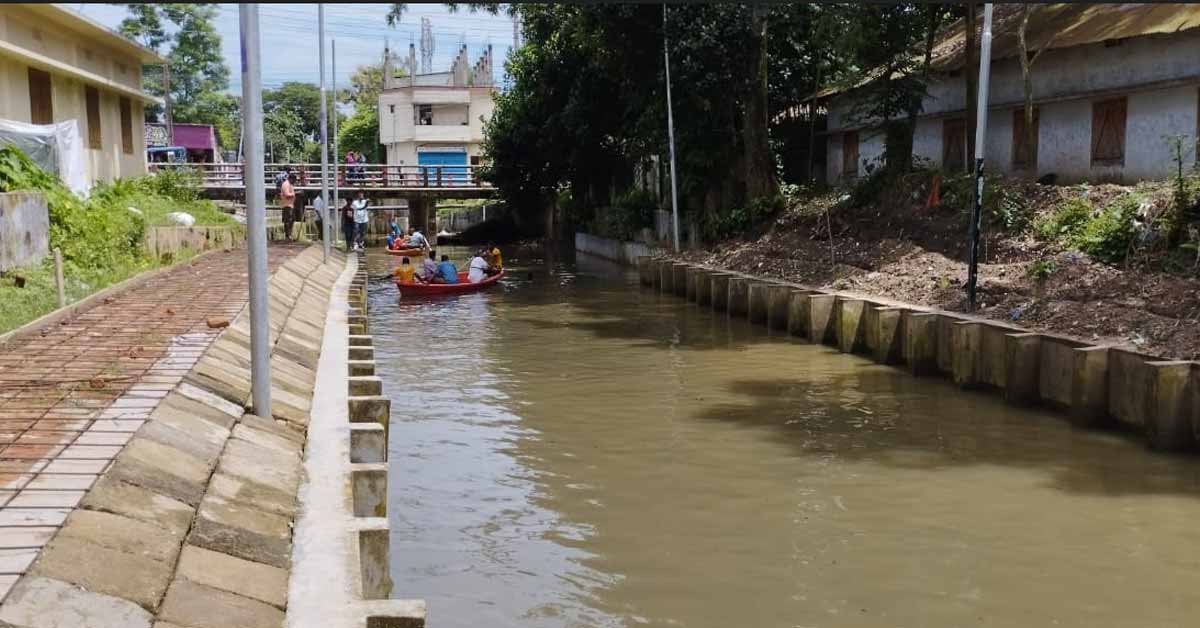Malik Fida A. Khan
Update: 01:09, 1 October 2025
Consequences and Implications of Climate Change for the Haor Region

Malik Fida A. Khan
While the Haor wetlands are inland, increased sea levels at the Bay of Bengal would impede the discharge of floodwater from the Meghna Basin during monsoon periods, causing accumulation upstream. The combination of subsidence and rising sea levels effectively reduces the usable elevation of Haor land. This synergistic effect heightens both the extent and duration of flooding in these low-lying regions.
Significance of the Haor Region
The Haor region in northeastern Bangladesh represents one of the nation’s most distinctive and sensitive ecosystems. Characterized by shallow floodplain depressions, these areas transform into expansive lakes during the monsoon and recede into beels in the dry season. Covering approximately 2 million ha about 14% of Bangladesh’s total land area, the haors support nearly 19.4 million residents whose livelihoods remain closely linked to the region’s natural resources.
This seasonal wetland serves as a significant biodiversity reservoir, sustaining over 154 indigenous fish species and providing essential winter habitats for hundreds of thousands of migratory birds. Fisheries are a cornerstone of both the local economy and national nutrition, with production reaching roughly 108,880 metric tons in 2018–19.
Agriculture is equally fundamental to the Haor economy. Often described as Bangladesh’s “rice bowl,” the basin contributes an estimated 18–20% of the nation’s total rice output. The primary Boro crop cultivated during the dry season utilizing residual flood moisture, accounts for around one quarter of all Boro rice grown nationwide. Districts such as Kishoreganj, Sunamganj, and Sylhet collectively produce almost one-fifth of annual rice yields. However, the region’s unique ecological conditions limit cropping intensity to about 104%, significantly below the national average of 195%, as only a single rice harvest per year is feasible due to regular monsoon flooding.
In addition to rice cultivation and fisheries, livestock rearing and exploitation of wetland resources further underpin the local economy. Despite this substantial ecological and economic value, the Haor region remains exceptionally vulnerable. Reliance on a single crop, coupled with exposure to frequent floods and environmental shocks, underscores both the critical importance and inherent fragility of the Haor ecosystem. This landscape is simultaneously a vital resource for millions and persistently at risk from natural and anthropogenic threats.
A Comprehensive Historical Analysis of Natural Disasters in the Haor Basin
The Haor region is significantly affected by frequent flooding, a consequence of its geographical location beneath India’s Meghalaya and Assam hills, areas notable for high rainfall. Annual pre-monsoon rains in March or April often result in flash floods that coincide with the ripening of the Boro rice crop. In April 2010, such an event led to the destruction of 30,000 hectares of agricultural land, resulting in a loss of approximately 150,000 metric tons of paddy, thereby jeopardizing both farmer livelihoods and national food security.
The 2017 flood proved exceptionally disruptive, with early flash floods in March followed by prolonged inundation causing near-total loss of crops: nearly 100% of Boro, 60% of Aus, and 45% of Aman rice were destroyed. Flood defenses such as embankments failed, soils were heavily impacted by sand and silt deposits, and waterways became obstructed, illustrating deficiencies in current flood protection measures.
In 2022, the region experienced its most severe flooding on record, driven by intense upstream rainfall including one of the heaviest downpours at Cherrapunji in 122 years which submerged approximately 80% of Sylhet division. Both Sylhet city and Sunamganj were submerged, displacing hundreds of thousands and leaving over four million people affected by consecutive floods in a single month. Experts attributed the exacerbation of the disaster to extreme precipitation, wetland encroachment, and inadequately planned infrastructure, all of which diminished the haors’ capacity for natural water storage and drainage.
Floods consistently inflict damage beyond agricultural losses, affecting homes, rural roads, embankments, and boats, and requiring substantial annual expenditures for repair. The recurring disasters in 2010, 2017, and 2022, alongside significant events in 1988 and 1998 demonstrate the intrinsic vulnerability of the Haor Basin to flooding. Intensification of rainfall under climate change and degradation of ecological buffers are expected to further elevate risks for local ecosystems and communities.
|
Year |
Event & Severity |
Key Impacts |
|
2010 |
Flash flood (April, pre-harvest) |
Destroyed 30,000 ha of Boro rice; ~150,000 MT paddy lost |
|
2017 |
Early flash flood + prolonged inundation (Mar–Nov) |
Nearly 100% Boro, 60% Aus, 45% Aman lost; embankments breached; soil fertility damaged by sand/silt |
|
2022 |
Record-breaking floods (June, double event) |
80% of Sylhet under water; >4 million affected; mass displacement; Sylhet & Sunamganj inundated; worsened by wetland loss & poor drainage |
|
Earlier (1988, 1998) |
Major floods |
Set historical precedent of recurring large-scale devastation |
Figure 1: Setting of the Haor Area
Impacts of Climate Change on the Haor Region
This distinctive bowl-shaped landscape demonstrates high productivity in both agriculture and fisheries; however, it is also acutely susceptible to climate-related hazards. Evidence of climate change in the Haor area includes shifts in rainfall patterns, increased frequency of flash floods, sedimentation in water bodies, and other environmental stressors. This technical summary identifies five critical impact areas sedimentation, flash floods, drainage congestion, wave erosion (referred to locally as afal), and changes in land elevation relative to sea level and examines their implications for climate adaptation and water management strategies within the Haor basin.
Sedimentation and Siltation Processes in Haor Wetlands
Heavy sediment loads from upland rivers deposit millions of tons of silt in the Haor wetlands annually, thereby decreasing the depth and water retention capacity of these natural floodplains. The Surma and Kushiyara Rivers, which are principal inflows to the Haor basin, transport an estimated 3.7 to 8.6 million tons of suspended sediment each year on average. A significant portion of this sediment settles within the Haor depressions and riverbeds, resulting in ongoing siltation. Sediment budget analyses demonstrate a net accumulation of approximately 8 million tons of sediment per year in the region. This persistent infilling has led to a reduction in flood storage volume and water retention capacity, causing floodwater to dissipate more slowly and inundate higher elevations than previously observed. Furthermore, siltation and encroachment have contributed to the loss of connectivity between haors, khals (canals), and rivers, thereby disrupting natural drainage patterns. Reduced storage and connectivity intensify flooding, as runoff cannot disperse or drain as efficiently as before. In summary, unchecked sedimentation is impairing the Haor wetlands’ capacity to mitigate floods and support dry-season water requirements, increasing the region’s vulnerability in the context of climate change.
Rising Incidence of Flash Floods
The Haor basin is experiencing increased susceptibility to flash floods, influenced by climate change-induced alterations in rainfall patterns and flood timing. Historically, significant flash floods occurred in late April or May; however, these events now frequently take place earlier, during late March or early April, coinciding with the critical harvest period for the Boro rice crop. This change is associated with heightened pre-monsoon rainfall in March and April, driven by more variable and intense meteorological conditions.
The consequences of these shifts have been substantial. In April 2010, a sudden flood resulted in the loss of approximately 30,000 hectares of rice fields, equating to around 150,000 metric tons of paddy. The 2017 season saw an unusually early and extended flood that breached embankments, leading to estimated crop losses valued at $1.49 billion and nearly devastating the entire Boro harvest.
The most significant incident occurred in 2022, when record rainfall in India’s Cherrapunji hills (972 mm within 24 hours, the highest recorded June precipitation in 122 years) precipitated severe flooding. This event impacted approximately 7.2 million people across nine northeastern districts, inundated 1,133 km² of cropland, and damaged over 44,000 fishponds. Collectively, these occurrences illustrate a discernible pattern: flash floods are increasing in frequency, intensity, and impact, posing serious threats to food security and the livelihoods of millions unless comprehensive adaptation strategies are implemented.
Drainage Constraints and Effect on Infrastructure
Over several decades, extensive flood-control infrastructure and unplanned development within the Haor basin have resulted in significant drainage challenges. To protect dry-season Boro crops from flash floods, approximately 3,000 km of submersible embankments, 128 regulators, 65 sluices, and various other structures have been constructed. Additionally, nearly 430 km of highways and an estimated 25,000 km of rural roads traverse these wetlands. Despite their intended purpose, many roads and embankments lack adequate culverts or drainage openings, thereby acting as barriers that trap runoff and exacerbate local flooding.
The impacts of climate change are intensifying these vulnerabilities, with increasingly severe rainfall events causing water levels to rise more rapidly than current infrastructure can accommodate. This leads to prolonged inundation of agricultural fields and adverse effects on both crops and livelihoods. The situation is further aggravated by narrowing canals and silted riverbeds, which reduce the capacity for natural drainage.
The Sylhet city floods of June 2022 exemplified the potential consequences. Historically drained by 26 canals, the city’s wetland connectivity diminished due to encroachment and insufficient maintenance. When extreme rainfall occurred, obstructed canals failed to manage the excess water, resulting in widespread submersion throughout Sylhet. This case underscores the necessity of restoring natural drainage systems and reevaluating infrastructure strategies to mitigate the risks posed by climate-induced heavy rainfall, which continue to threaten urban and rural areas with flooding.
|
Climate Change Effect |
Evidence & Scale |
Impacts |
|
Intense rainfall |
Heavier pre-monsoon & monsoon downpours |
Embankments/roads trap water, prolong floods |
|
Infrastructure overload |
3,000 km embankments, 25,000 km rural roads, few drainage outlets |
Localized congestion, waterlogging |
|
Canal loss & siltation |
26 canals in Sylhet mostly blocked |
Urban flooding in 2022, citywide inundation |
|
Compounding risks |
Climate change + poor planning |
Crop losses, infrastructure damage, prolonged displacement |
Wave Erosion and the Disappearance of Villages
In the Haor wetlands, wave erosion, locally referred to as afal, has emerged as a significant climate-related hazard. Annually, from May to October, monsoon winds generate substantial waves across the inundated basin, which continuously impact earthen village mounds and embankments, progressively weakening them. Historically, shoreline vegetation played a vital role in absorbing wave energy; however, deforestation, loss of grass, and cultivation extending to the water’s edge have eliminated these natural defensive barriers. Consequently, waves now exert greater force, accelerating soil erosion and causing the collapse of homesteads within minutes during severe weather events.
The implications are considerable. In Netrokona District, at least 23 villages have already been lost due to wave erosion, and approximately 60 more in Khaliajuri upazila remain at imminent risk. Waves reaching 3–4 feet frequently displace families, compelling them to inhabit increasingly limited land or relocate entirely. Beyond residential loss, wave erosion diminishes arable land, damages infrastructure, and exacerbates poverty.
To mitigate these impacts, experts recommend re-establishing “green belts” comprising swamp forest species such as hijol and karoch, along with vetiver grass on embankments to function as natural wave barriers. Supplemented by bamboo structures and modified cropping practices, these interventions can enhance the resilience of Haor communities against the intensifying effects of climate-driven afal waves.
|
Climate Change Effect |
Evidence & Scale |
Impacts |
|
Stronger winds & waves |
3–4 ft waves during monsoon (May–Oct) |
Rapid collapse of homesteads and embankments |
|
Loss of vegetation buffers |
De-plantation, cropping to water’s edge |
Villages exposed directly to wave force |
|
Village disappearance |
23 villages already lost in Netrokona |
Land shrinkage, displacement of families |
|
Growing threat |
60 villages at risk in Khaliajuri |
Repeated displacement, insecure livelihoods |
|
Adaptation needs |
Green belts (hijol, karoch), vetiver grass, bamboo screens |
Living wave-breaks, soil stabilization, safer settlements |
Land Elevation, Subsidence, and Sea-Level Rise
The Haor region is characterized by exceptionally low-lying topography, rendering it highly susceptible to flooding and sensitive to even minor shifts in relative sea level. Elevation data reveal that approximately 50% of the total area lies merely 3–4 meters above mean sea level (Figure 1). Furthermore, nearly half of the individual haors (170 out of 373) are categorized as “deeply flooded” wetlands, with basin floors situated within 1 meter of the surface datum, indicating extremely low elevation. These depressions routinely retain water depths of 4–6 meters during the monsoon season. Consequently, any increase in regional water levels or impediments to drainage can significantly affect these areas, leading to sustained inundation.
Complicating this situation, natural land subsidence is ongoing within the Haor basin, further reducing ground elevation over time. Geological research indicates that the Sylhet sub-basin (in the northern Haor region) is experiencing subsidence due to tectonic activity at rates of up to 6 mm per year in certain localities, while broader estimates suggest 2–4 mm annually across the floodplain. This gradual sinking intensifies flood risks, particularly as river sediment accumulates and raises bed levels concurrently.
In addition, global sea-level rise (SLR) is projected to impact the hydrology of the Haor region through backwater effects on the Meghna River, which serves as its primary drainage outlet. Climate models for Bangladesh predict a mean sea level rise of approximately 30 cm by 2050 under moderate scenarios and potentially up to 95 cm by 2100 if high global emissions persist (IPCC AR6). While the Haor wetlands are inland, increased sea levels at the Bay of Bengal would impede the discharge of floodwater from the Meghna Basin during monsoon periods, causing accumulation upstream. The combination of subsidence and rising sea levels effectively reduces the usable elevation of Haor land. This synergistic effect heightens both the extent and duration of flooding in these low-lying regions.
Deeply flooded haors, presently positioned at or just below river level for half the year, may experience longer periods of inundation in future as drainage outlets remain elevated for extended times. Sea-level rise amplifies existing vulnerabilities in the Haor region by increasing both flood intensity and persistence. Unlike direct coastal inundation, the primary risk here is indirect: low elevation and continuing land subsidence exacerbate hydrological backwater effects. Hydrodynamic modelling suggests that a one-meter increase in Bay of Bengal Sea level could raise water levels along the Upper Meghna River, substantially slowing floodwater drainage from the Haor (CEGIS, 2024). Elevated downstream water levels result in higher pressure at basin drainage points, delaying the recession of floodwater and prolonging inundation across the region’s low-lying terrain. Collectively, these factors highlight the considerable vulnerability of the Haor landscape to prolonged flooding in the context of rising sea levels.
|
Climate Change Effect |
Evidence & Scale |
Impacts |
|
Low elevation |
50% of land at 3–4 m above sea level; 170 haors within 1 m |
Naturally flood-prone; prolonged inundation |
|
Land subsidence |
Up to 6 mm/year in Sylhet; 2–4 mm/year elsewhere |
Land sinks while riverbeds rise → worsens flooding |
|
Sea-level rise |
30cm by 2050; 95 cm by 2100 |
Slows Meghna drainage; backwater floods into Haor |
|
Combined effect |
1 m SLR pushes water up Upper Meghna |
Longer, deeper monsoon floods |
|
Rainfall shift |
Peak rainfall moving earlier (July → May) |
Higher flood peaks coinciding with already high-water levels |
The combined effects of low land elevation, subsidence, and rising sea levels present significant challenges for flood management in the Haor basin. These circumstances highlight the need for proactive strategies such as enhanced flood forecasting systems, adaptive land-use planning that accommodates periodic flooding, and infrastructure modifications to address evolving environmental conditions.
"Haor at Risk: A Summary of Climate Change Effects"
Heavy Sedimentation: The Surma and Kushiyara Rivers collectively deposit approximately 3.7–8.6 million tons of sediment each year, resulting in a net annual accumulation near 8 million tons. This process progressively decreases Haor depth and impairs water retention capacity.
Loss of Storage & Connectivity: Increased siltation and land encroachment have significantly disrupted natural hydrological connections among haors, rivers, and canals. These changes slow flood recession and contribute to persistent waterlogging.
Earlier Flash Floods: Whereas flash floods previously occurred in late April to May, they now frequently arise by late March. This shift coincides with the ripening period for Boro rice, thereby increasing the risk and uncertainty of harvest.
Crop Losses: Major flooding events led to the destruction of 30,000 hectares in 2010, almost a complete loss of the Boro crop in 2017 (estimated at USD 1.49 billion), and in 2022 inundated 1,133 km² of cropland, affecting roughly 7.2 million individuals.
Infrastructure Bottlenecks: Approximately 3,000 km of embankments and 25,000 km of rural roads lack adequate culvert infrastructure, functioning as unintended dams that retain floodwater rather than facilitating drainage.
Urban Drainage Failures: In Sylhet, most of the city's original 26 drainage canals are now obstructed, which contributed to widespread urban flooding in 2022.
Wave Erosion (Afal): Monsoon-driven winds generate waves of 3–4 feet from May to October, leading to erosion of homesteads and embankments. Twenty-three villages have already been lost in Netrokona and an additional sixty remain at risk in Khaliajuri.
Loss of Natural Buffers: The disappearance of traditional shoreline vegetation, such as chailya grass, has left banks vulnerable to wave action, accelerating both land shrinkage and displacement of populations.
Low Elevation & Subsidence: Nearly 50% of Haor land lies at elevations between 3–4 meters. Subsidence rates of 2–6 mm per year compound with rising riverbeds, elevating flood risk in these areas.
Sea-Level Rise Backwater Effect: Projections indicate that a 1 m increase in Bay of Bengal Sea level could result in elevated water levels reaching the Upper Meghna, slowing Haor drainage and further prolonging flood durations (CEGIS, 2024).
Malik Fida A. Khan, Executive Director, Center for Environmental and Geographic Information Services
- A fire broke out in Bongo Bazar
- Takrim again first in the International Quran Competition
- Bangladesh Chhatra League full committee announced
- Enayetullah Abbasi may be banned in UK!
- Today is the birthday of the father of the nation
- Sheikh Hasina will be elected for the fourth term : Bloomberg
- Fire in Bongo Bazar: Mamun lost everything
- I will help victims of Bongo Bazar : Prime Minister
- Heat wave in 7 divisions, day and night temperature will increase
- Delwar Hossain Sayeedi passed away!































